Characteristics
-
All
the G.L. of past & present have common linguistic features, some
of these features are shared by other groups in the IE family,
others are specifically Germanic. -
The
Germanic group of lang. acquired their specific distinctive features
after the separation of the ancient Germanic tribes from other IE
tribes and prior to their expansion and disintegration that is
during the period of the Proto Germanic language ( unattested). The
aim is to provide the general idea of what the PGLang was like, to
point out its linguistic ftatures. Theese PGfeatures, inherited by
the descendant l-ges, represent the common features of the Germanic
group. -
Other
common features developed later in the course of individual history
of separate Germanic l-ges as a result of similar tendencies from PG
causes. On the other hand many Germanic features have been
disguised, transformed and even lost in later history.
Germanic
languages possess several unique features, such as the following:
-
A
large class of verbs that use a dental suffix(/d/ or /t/) instead ofvowel
alternation(Indo-European
ablaut) to indicate past tense; these are called theGermanic
weak verbs; the remaining verbs with vowel ablaut are theGermanic
strong verbs -
The
shifting of stressaccent onto the root of the stem and later to the first syllable of
the word -
Another
characteristic of Germanic languages is the verb
second
or V2
word order.
This feature is shared by all modern Germanic languages except
modern English -
Strict
differentiation of short and long vowels -
Tendency
for assimilation and reduction -
A
great number of fricatives, small number of plosives -
No
palatal consonants at all.
-
English
as a world language.
English
is a West
Germanic language
that developed in England
during the Anglo-Saxon
era,
in
the fifth century AD when Germanic tribes began to move from their
homes in Northern Germany and Jutland in order to settle in
Britannia.
Historically,
English originated from several dialects, now collectively termed Old
English,
which were brought to the island
of Great Britain
by Anglo-Saxon
settlers beginning in the 5th century. English was further influenced
by the Old
Norse language
of Viking
invaders. At the time of the Norman
conquest(1066),
Old English developed into Middle
English.
As a result of influence of the British
Empire
during the 18th, 19th, and early 20th centuries, and of the United
States
since the mid 20th century, Eng. has become the lingua
franca
in many parts of the world. English today is probably the third
largest language by number of native speakers, after Mandarin
Chinese
and Spanish.
The
countries with the highest populations of native English speakers
are: United
States
(215 million), United
Kingdom
(61 million), Canada (18.2 million),Australia
(15.5 million), Nigeria (4 million),Ireland (3.8 million), South
Africa (3.7 million), and New Zealand (3.6 million) 2006. Eng. is the
required international
language
of communications, science, business, aviation, entertainment, radio
and diplomacy. English is the language most often studied as a
foreign language in the European Union (by 89% of schoolchildren).
Books, magazines, and newspapers written in English are available in
many countries around the world. English is also the most commonly
used language in the sciences.
p.
106-108
-
In
PIE there were two ways of word accentuation:
-
musical
pitch(tone) -
force(dynamic)
stress
The
position of stress was free & moveable. It could fall on any
syllable of a word: on a root morpheme, on an affix, or even on the
ending. It could be shifted . Both these properties of stress were
changed in common Germanic.
-
In
PG force stress( dynamic or breath) became the only type of stress
used. In early PG the stress was still moveable, but in late PG the
position of stress was fixed on the first syllable (either root or
prefix), all the other syllables were unstressed.. The fised words
stress has played an important role in phonetic and morphological
development.
Consequences:
the
vowels of non-initial syllables became unstressed & therefore
they were weakened & could be lost.(Verrners law) The 1st
syllable of a word was given a special prominence.
-
The
Proto-Germanic phonology. The consonants.
Periodization
-
Early
PG (15/5c. BC — 1/4c. AD)—-
separation of PG from the west IE (centum branch) to its
stabilization as a separate system.
Features:
(it possessed a lot of linguistic features typical of PIE)
-
the
existence of the fixed & moveable stress types -
there
didn’t exist any difference between stressed & unstressed
syllables. -
The
3-morphe structure of the word -
The
existence of two-tense aspect stems in the system of the verb (the
Infect and Perfect stems)
-
Late
PG (4/7c. – 11/16c. AD)—- from
stabilization of PG to its dispersal into separate groups of
Germanic dialects .
Features:
(it acquired a lot of specific features of its own)
-
the
dynamic stress was fixed on the first root syllable -
the
opposition between stressed & unstressed syllables. -
The
3-morpheme structure of the word developed into the 2 – morpheme
structure -
PG
tense forms developed from PIE tense-aspect stems
CONSONANTS:
(p.52) ТАБЛИЦА
Common
features in PG:
-
a
great number of fricatives, small number of plosives; -
no
palatal consonants at all, as in other Centum languages.
Such
a quantity of fricatives appeared in PG as a result of sound shifting
described as Grimm’s Law and Verner’s Law.
-
The
first consonant shifting (Grimm’s Law).
Grimms
Law expresses regular correspondences between IE and Germanic
consonant . Rasmus Rask was the fist to open the phenomenon in 1818.
and Jacob Grimm described the changes in his “Deutch Grammar” in
1822).
Essence:
the type of articulation changes while the place of articulation
remains unchanged. As a result there appeared more fricatives in
Germanic languages than there were in IE l-ges.
The
correspondences were grouped under three categories ( acts). Each of
the acts coered quite a long period of time of 100 years and more.
|
I |
IE
p f
t Ө
k
kw |
L |
|
II |
IE
b
d
g
gw kw |
R |
|
III |
IE
bh
dh
gh
gwh |
Skr |
Exceptions:
-
The
shifting didn’t take place after fricatives(f,
Ө,h) & s:
L
stare – Gt standan
-
The
second of the consonants didn’t undergo shifting:
L
octo
Gt ahtau
1 k > h
12
12 2 t = t
Соседние файлы в предмете [НЕСОРТИРОВАННОЕ]
- #
- #
- #
- #
- #
- #
- #
- #
- #
- #
- #
Слайд 1
Linguistic features of Germanic languages

Слайд 2
Phonetics – 1) word stress
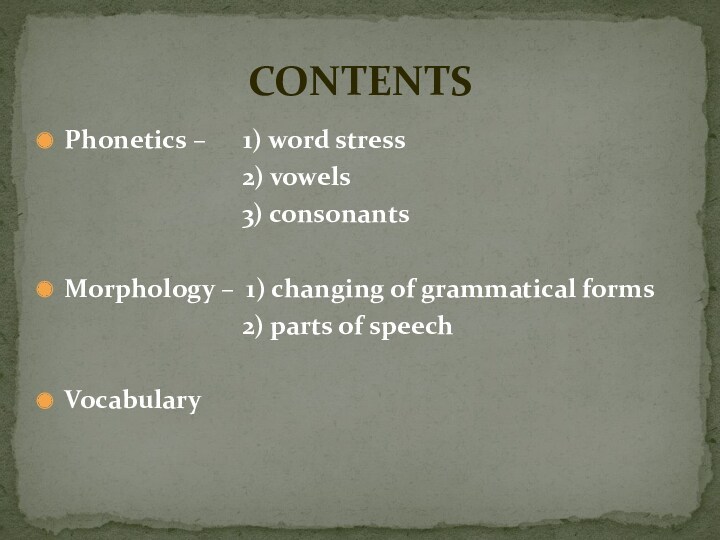
2) vowels
3) consonants
Morphology – 1) changing of grammatical forms
2) parts of speech
Vocabulary
CONTENTS
Слайд 3
Early Proto-Germanic – free and movable
Late Proto-Germanic –
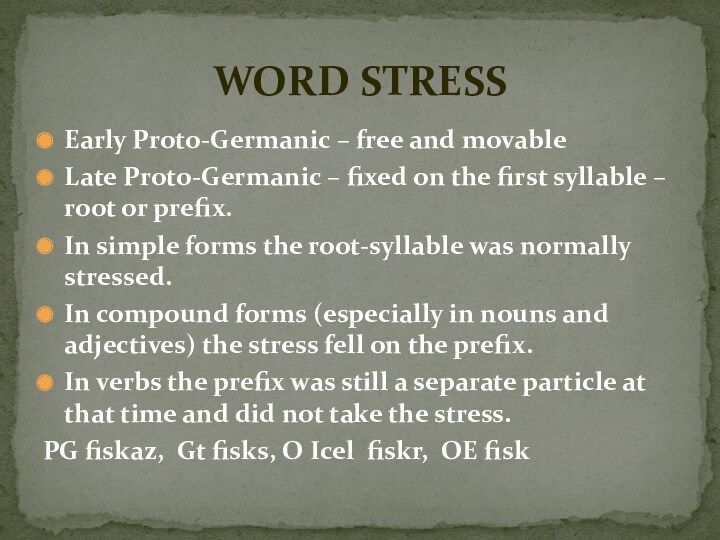
fixed on the first syllable – root or prefix.
In simple forms the root-syllable was normally stressed.
In compound forms
(especially in nouns and adjectives) the stress fell on the prefix.
In verbs the prefix was still a separate particle at that time and did not take the stress.
PG fiskaz, Gt fisks, O Icel fiskr, OE fisk
WORD STRESS
Слайд 4
IE short /ŏ/ and /ǎ/ correspond to GLs
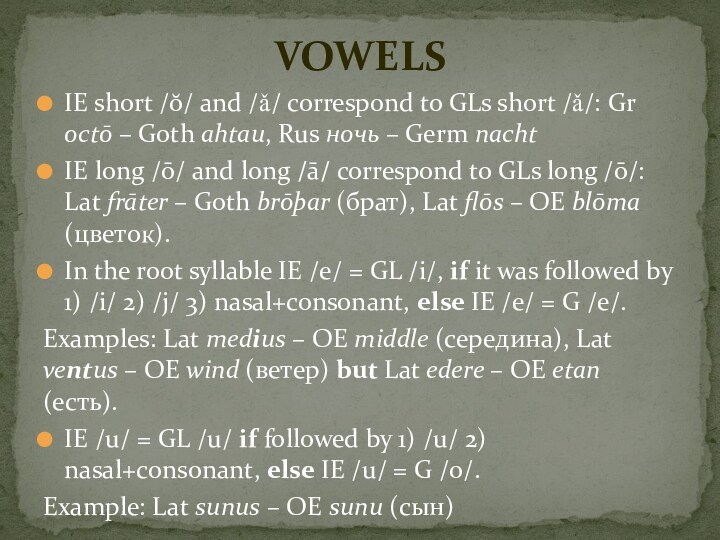
short /ǎ/: Gr octō – Goth ahtau, Rus ночь
– Germ nacht
IE long /ō/ and long /ā/ correspond to
GLs long /ō/: Lat frāter – Goth brōþar (брат), Lat flōs – OE blōma (цветок).
In the root syllable IE /e/ = GL /i/, if it was followed by 1) /i/ 2) /j/ 3) nasal+consonant, else IE /e/ = G /e/.
Examples: Lat medius – OE middle (середина), Lat ventus – OE wind (ветер) but Lat edere – OE etan (есть).
IE /u/ = GL /u/ if followed by 1) /u/ 2) nasal+consonant, else IE /u/ = G /o/.
Example: Lat sunus – OE sunu (сын)
VOWELS
Слайд 5
The 1st Consonant Shift, or Grimm’s Law
IE
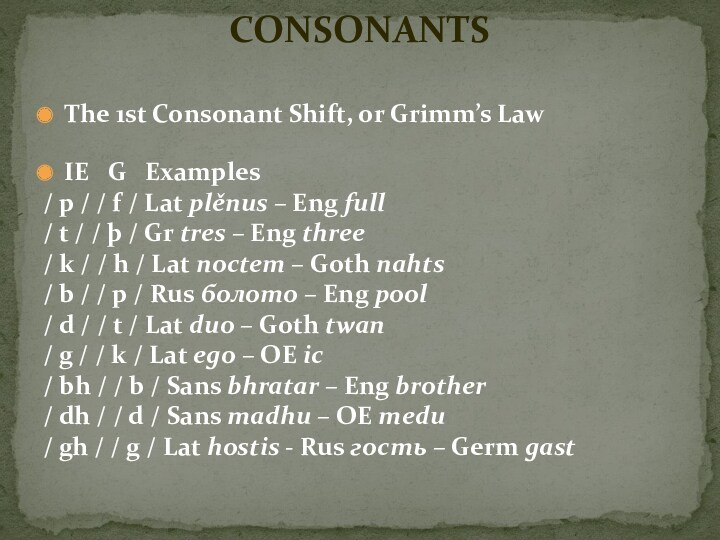
G Examples
/ p / / f / Lat
plěnus – Eng full
/ t / / þ / Gr
tres – Eng three
/ k / / h / Lat noctem – Goth nahts
/ b / / p / Rus болото – Eng pool
/ d / / t / Lat duo – Goth twan
/ g / / k / Lat ego – OE ic
/ bh / / b / Sans bhratar – Eng brother
/ dh / / d / Sans madhu – OE medu
/ gh / / g / Lat hostis — Rus гость – Germ gast
CONSONANTS
Слайд 6
Verner’s Law: unstressed vowel + voiceless stop

voiceless fricative voiced fricative
voiced stop: /t/ /þ/ /ð /
/d/ Gr patěr=> OE fæder.
The consonant pairs involved in grammatical alternation were f/b, þ/d, h/g, hw/w, s/r.
Some words retained traces of Verner’s Law:
death – dead was – were
CONSONANTS
Слайд 7
Inflections were the principal means of form-building .
Sound
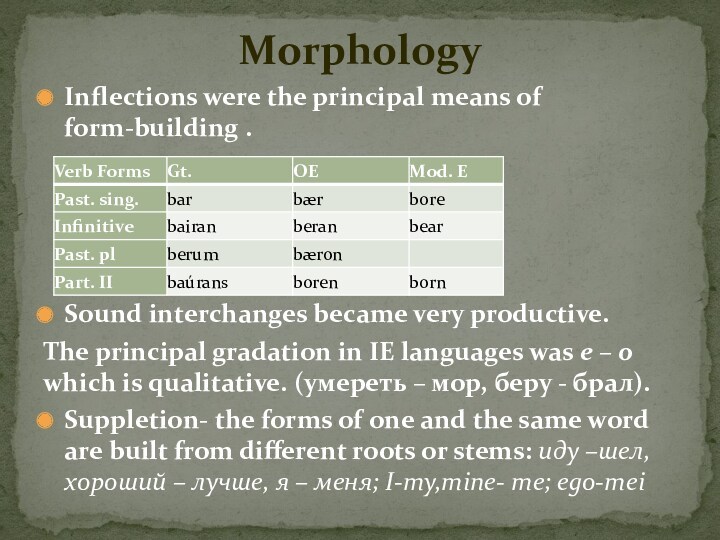
interchanges became very productive.
The principal gradation in IE languages
was e – o which is qualitative. (умереть – мор,
беру — брал).
Suppletion- the forms of one and the same word are built from different roots or stems: иду –шел, хороший – лучше, я – меня; I-my,mine- me; ego-mei
Morphology
Слайд 8
Classes of nouns: 1. vocalic stems a, o,
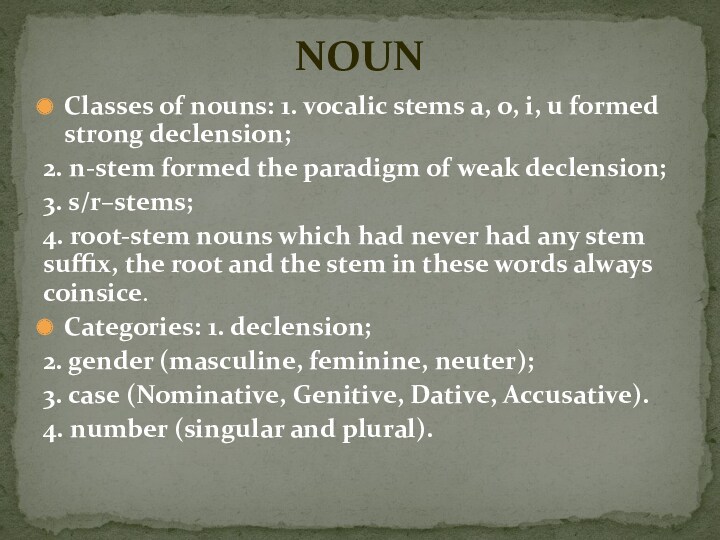
i, u formed strong declension;
2. n-stem formed the paradigm
of weak declension;
3. s/r–stems;
4. root-stem nouns which had never had
any stem suffix, the root and the stem in these words always coinsice.
Categories: 1. declension;
2. gender (masculine, feminine, neuter);
3. case (Nominative, Genitive, Dative, Accusative).
4. number (singular and plural).
NOUN
Слайд 9
Adjective declension in all GLs has no parallel
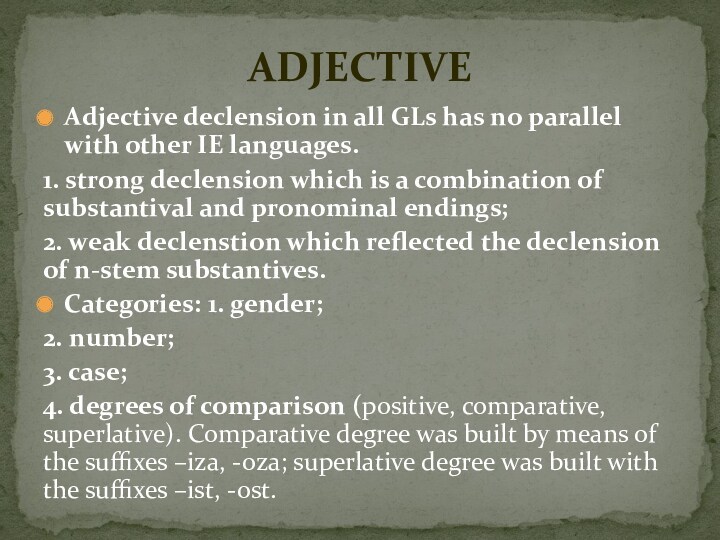
with other IE languages.
1. strong declension which is a
combination of substantival and pronominal endings;
2. weak declenstion which reflected
the declension of n-stem substantives.
Categories: 1. gender;
2. number;
3. case;
4. degrees of comparison (positive, comparative, superlative). Comparative degree was built by means of the suffixes –iza, -oza; superlative degree was built with the suffixes –ist, -ost.
ADJECTIVE
Слайд 10
The oldest classes are personal, demonstrative and interrogative.
Personal
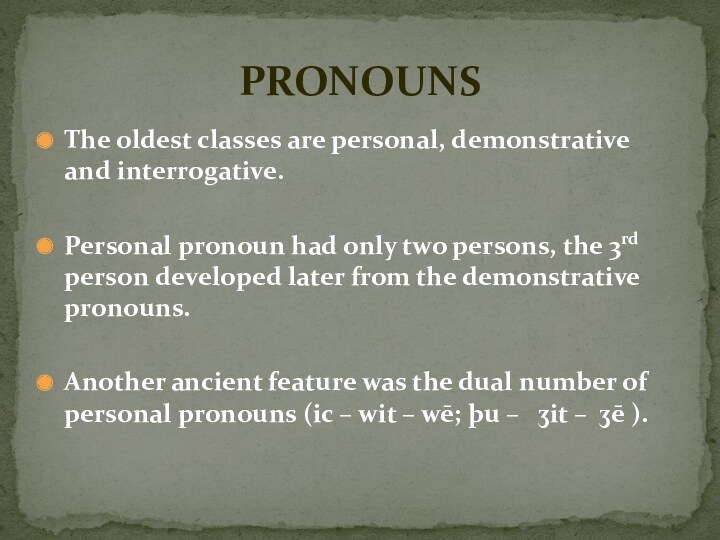
pronoun had only two persons, the 3rd person developed
later from the demonstrative pronouns.
Another ancient feature was the dual
number of personal pronouns (ic – wit – wē; þu – ʒit – ʒē ).
PRONOUNS
Слайд 11
1. Strong verbs (had four principal forms —
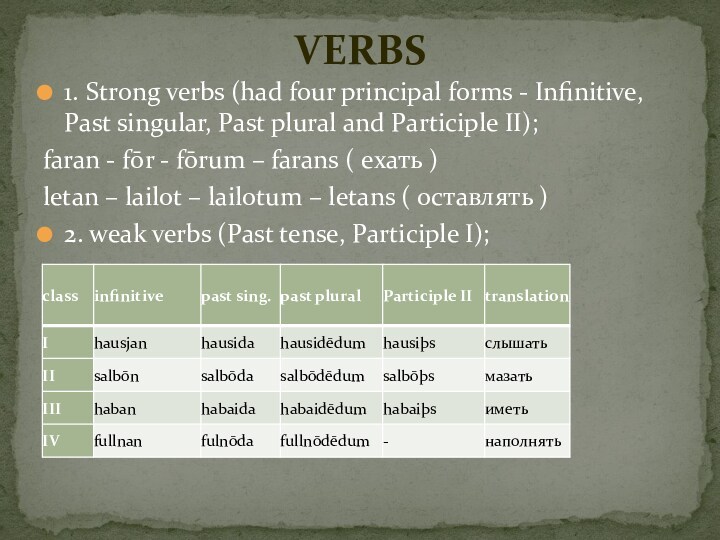
Infinitive, Past singular, Past plural and Participle II);
faran —
fōr — fōrum – farans ( ехать )
letan –
lailot – lailotum – letans ( оставлять )
2. weak verbs (Past tense, Participle I);
VERBS
Слайд 12
3. united preterit-present verbs (used vowel gradation to
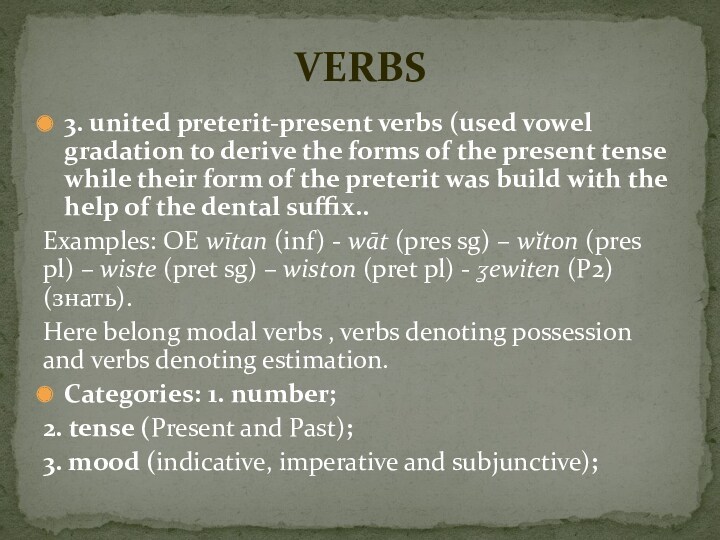
derive the forms of the present tense while their
form of the preterit was build with the help of
the dental suffix..
Examples: OE wītan (inf) — wāt (pres sg) – wĭton (pres pl) – wiste (pret sg) – wiston (pret pl) — ʓewiten (P2) (знать).
Here belong modal verbs , verbs denoting possession and verbs denoting estimation.
Categories: 1. number;
2. tense (Present and Past);
3. mood (indicative, imperative and subjunctive);
VERBS
Слайд 13
IE words
Pure Germanic words
VOCABULARY
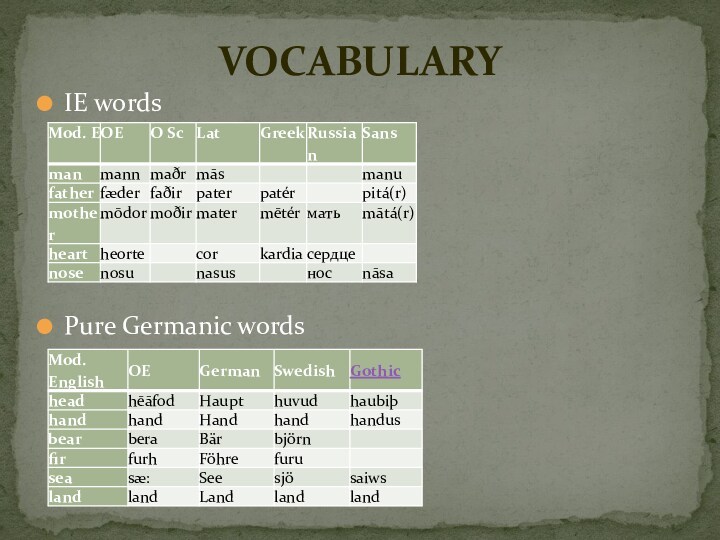
Скачать материал

Скачать материал






- Сейчас обучается 396 человек из 63 регионов


Описание презентации по отдельным слайдам:
-
1 слайд
GENERAL CHARACTERISTICS
OF THE GERMANIC
LANGUAGES -
2 слайд
OUTLINE
1. Phonetics
2. Grammar
3. Vocabulary
-
3 слайд
the 5th c. AD — the ruthless and barbaric Germanic tribes of Angles, Saxons, Jutes, Frisians, who up to that time had lived in western Europe between the Elbe and the Rhine, started their invasion of the British Isles.
“Romanised Celts”
The Celtic tribes (their languages are represented in modern times by Irish, Scottish Gaelic, Manx, Welsh, Cornish, Breton)The Roman Invasion
-
-
5 слайд
Table 1
Classification of old and modern Germanic languages -
6 слайд
MAIN CHARACTERISTICS OF THE GERMANIC LANGUAGES
The principal features common to all the languages of the Germanic language area were:
fixation of the main stress on the initial syllable of the word;
(ii) the first, or Germanic sound shift affecting the Indo-European voiceless and voiced stops and the spirant [s];
(iii) certain vowel changes;
(iv) reduction in the number of cases as compared to Common Indo-European;
(v) full development of the weak declension of the adjective with a particular categorial meaning;
(vi) development of a dental preterite and appearance of the strong/weak verb distinction;
(vii) a peculiar alphabet. -
7 слайд
WORD STRESS
1) Fixed position of the stress
The main stress fell on the root-syllable and never shifted in building grammatical forms.
English: be’come, be’coming, over’come; ‘lover, ‘loving, be’loved;
German: ‘Liebe, ‘lieben ‘liebte, ge’liebt, ‘lieberhaft, ‘Liebling.
(cf. these native words with words of foreign origin which move the stress in derivation, though never in form-building: ex’hibit v, exhi’bition n).
2) Many endings merged with the suffixes, were weakened and dropped
PG *fiskaz, Gt fisks, O Icel fiskr, OE fisc. -
8 слайд
Vowels. Types of changes
qualitative changes affect the quality of the sound, e.g.: [o>a] or [p>f];
quantitative changes make long sounds short or short sounds long, e.g.: [i>i:], [ll>l];
dependent changes (also positional or combinative) are restricted to certain positions or phonetic conditions, for instance, a sound may change under the influence of the neighbouring sounds or in a certain type of a syllable;
independent changes — also spontaneous or regular — take place irrespective of phonetic conditions, i.e. they affect a certain sound in all positions. -
9 слайд
Strict differentiation of long and short vowels is commonly regarded as an important characteristic of the Germanic group.
After the changes, in Late PG, the vowel system, contained the following sounds:
SHORT VOWELS i e a o uLONG VOWELS i: e: a: o: u:
In addition to these monophthongs PG had a set of diphthongs made up of more open nuclei and closer glides:
[ei], [ai], [eu], [au] and also [iu];Nowadays many scholars interpret them as sequences of two independent monophthongs.
-
10 слайд
Ablaut or gradation is a spontaneous, positionally independent аlteration of vowels inhabited by the Germanic languages from the Common Indo-European period. This ancient phenomenon consisted in alteration of vowels in the root, suffix or ending depending on the grammatical form or meaning of the word.
ABLAUT -
11 слайд
TYPES OF ABLAUT
The qualitative Ablaut is the alteration of different vowels, mainly the vowels [e] / [a] or [e] / [o]
Old Icelandicbera (to give birth) — barn (baby)
Old High German stelan (to steal) — stal (stole)
Cf.: Russian бреду (I stroll, I wade) — брод (ford, wade)
Latintego (to cover, to cloth) — toga (clothes)
Quantitative Ablaut means the change in length of qualitatively one and the same vowel: normal, lengthened and reduced. A classic example of the Indo-European Ablaut is the declension of the Greek word “pater” (father):
[e:] [e] [ — ]
patēr patěr patros
(nominative case, (vocative case, (genitive case,lengthened stage)
normal stage) reduced stage) -
12 слайд
Ablaut in Germanic languages is a further development of Indo-European alterations.
quantitative ablaut Goth qiman (to come) — qums (the arrival)
qualitative ablaut OHG stelan (to steal) — stal (stole)
quantitative+qualitative ablaut OE findan (to find) — fand (found, past tense) — fundan (found, past part.).
Ablaut as a kind of an internal flexion functioned in Old Germanic languages both in form- and word-building, but it was the most extensive and systematic in the conjugation of strong verbs. -
13 слайд
The first consonant shift, or Grimm’s law
The law explains correspondences found between Indo-European and Germanic consonants in the following manner: the Germanic sounds are the result of a development of the original Indo-European sounds, as they existed in the Indo-European ancestor language:
IE p becomes Germc. f. IE t becomes Germc. p, etc.IE Germanic IE Germanic IE Germanic
p > f b > p bh > b
t > T d > t dh > d
k > x g > k gh > g -
14 слайд
Verner’s Law
Verner’s Law explains some correspondences of consonants which seemed to contradict Grimm’s Law and were for a long time regarded as exceptions.
According to Verner’s law all the early PG voiceless fricatives [f, θ, x] which arose under Grimm’s Law, and also [s] inherited from PIE, became voiced between vowels if the preceding vowel was unstressed; in the absence of these conditions they remained voiceless.
The voicing occurred in early PG when the stress was not yet fixed on the root-morpheme. The process of voicing can be shown as a step in a succession of consonant changes in prehistorical reconstructed forms.
e.g. the changes of the second consonant in the word father: PIE Early PG Late PG
*pa΄ter> *fa΄θar > *fa΄ðar > > *΄faðar -
15 слайд
Grammar
change in the word structure.
in Early PG the word consisted of three main component parts: the root, the stem-suffix (a means of word derivation) and the grammatical ending (a marker of grammatical form)
in Late PG the old stem-suffixes lost their derivational force and merged with other components of the word, usually with the endings.
The word was simplified: the three-morpheme structure was transformed into a two-morpheme structure. The original grammatical ending, together with the stem-suffix formed a new ending: -
16 слайд
e.g. PG *fisk-a-z Gt fisks (NE fish)
PG *mak-ōj-an OE mac-ian, Past Tense mac-ode
(NE make, made)
In Gt fisks the stem-suffix was dropped, in OE macian, macode it merged with the ending, preserving one of the sounds — [i] or [o].)
The simplification of the word structure and the loss of stem-suffixes as distinct components was caused by the heavy Germanic word stress fixed on the root. -
17 слайд
Germanic languages belonged to the synthetic type of form-building, which means that
they expressed the grammatical meanings by changing the forms of the word itself, not resorting to any auxiliary words.
The Germanic nouns had:
four cases (nominative, genitive, dative, accusative)
two number forms (singular and plural)
the category of gender (feminine, masculine and neuter)
The means of form-building were the endings added to the root/stem of the noun. -
18 слайд
The Germanic adjectives had:
two types of declension (called strong and weak). Most adjectives could be declined both in accordance with the strong and weak type.
agreed with the noun in gender, case and number
the adjective by its type of declension expressed the idea of definiteness (weak declension) or indefiniteness (strong declension), the meaning which was later to become expressed by a grammatical class of words unknown in Common Germanic — the article.
degrees of comparison (formed with the help of suffixes -iz/ōz and –ist/-ōst)
there were instances of suppletivism, i.e. use of different roots for different forms — a means common for mаnу Indo-European languages:
Goth leitils—minniza—minnists (little—less—least)
Rus хороший—лучше—лучший -
19 слайд
strong verbs had preserved the richness of form since the age of the parent-language
weak verbs lacked such variety of form.
the main difference between these groups lies in the means of building the principal forms: the Present tense, the Past tense and Participle II.
the strong verbs built their principal forms with the help of root vowel interchanges plus certain grammatical endings; they made use of IE ablaut with certain modifications due to phonetic changes and environment.
Weak verbs built the Past tense and Participle II by inserting a dental suffix (an interdental fricative consonant) between the root and the ending.
Infinitive Past Tense Participle II NE
Gt domjan domida [D] domips deem, deemed
OE macian macode macod make, madeStrong and Weak Verbs
-
20 слайд
The Germanic verb had a well-developed system of categories:
person (first, second, third),
number (singular and plural),
tense (past and present, the latter also used for expressing future actions),
mood (indicative, imperative and optative),
voice (only in Gothic—active and mediopassive).The categorial forms employed synthetic means of form-building.
-
21 слайд
The IE etymological layer in the Germanic vocabulary is made up of words (or roots) shared by most IE languages. They refer to a number of semantic spheres:
— natural phenomena and animals,
— terms of kinship,
— verbs denoting basic activities of man,
— some pronouns and numerals.
the common IE element also includes word-building affixes and grammatical inflections.
VOCABULARY -
-
23 слайд
the purely Germanic words occur in Germanic alone and have no parallels outside the group
they appeared in PG or in later history of separate languages from purely Germanic roots
semantically they belong to basic spheres life: nature, sea,home life.
the specifically Germanic layer includes not only roots but also affixes and word-building patterns.
VOCABULARY -
24 слайд
Table
Specifically Germanic Words and Word Building Patterns -
25 слайд
Borrowings
were made in Late PG at the time when the Germanic tribes lived close together as a single speech community
e.g. the name of the metal iron was borrowed from the Celtic languages in Late PG
cf. Celt isarno, Gt eisarn, О Icel isarn, OE isen, iren.
(The Teutons may have learnt the processing of iron from the Celts.)
A large number of words must have been borrowed from Latin prior to the migration of West Germanic tribes to Britain. (These words reflect the contacts of the Germanic tribes with Rome and the influence of the Roman civilization on their life; they mostly refer to trade and warfare)
e.g. L pondō, Gt pund, О Icel pund, OE pund, NE pound
L prunus, О Icel рlómа, OE plūme, NE plum
L strata via, OHG strâza, OS strâta, OE stræt, NE street
Найдите материал к любому уроку, указав свой предмет (категорию), класс, учебник и тему:
6 209 883 материала в базе
- Выберите категорию:
- Выберите учебник и тему
-
Выберите класс:
-
Тип материала:
-
Все материалы
-
Статьи
-
Научные работы
-
Видеоуроки
-
Презентации
-
Конспекты
-
Тесты
-
Рабочие программы
-
Другие методич. материалы
-
Найти материалы
Другие материалы
- 23.12.2020
- 184
- 0
- 09.12.2020
- 140
- 0
- 28.10.2020
- 318
- 6
- 17.10.2020
- 428
- 1
- 27.09.2020
- 115
- 0
- 08.09.2020
- 177
- 0
- 03.09.2020
- 376
- 0
- 17.08.2020
- 232
- 2
Вам будут интересны эти курсы:
-
Курс повышения квалификации «Подростковый возраст — важнейшая фаза становления личности»
-
Курс профессиональной переподготовки «Экскурсоведение: основы организации экскурсионной деятельности»
-
Курс профессиональной переподготовки «Клиническая психология: организация реабилитационной работы в социальной сфере»
-
Курс повышения квалификации «История и философия науки в условиях реализации ФГОС ВО»
-
Курс повышения квалификации «Основы построения коммуникаций в организации»
-
Курс повышения квалификации «Применение MS Word, Excel в финансовых расчетах»
-
Курс повышения квалификации «Маркетинг в организации как средство привлечения новых клиентов»
-
Курс повышения квалификации «Экономика: инструменты контроллинга»
-
Курс повышения квалификации «Финансы: управление структурой капитала»
-
Курс повышения квалификации «Страхование и актуарные расчеты»
-
Курс повышения квалификации «Использование активных методов обучения в вузе в условиях реализации ФГОС»
-
Курс профессиональной переподготовки «Уголовно-правовые дисциплины: теория и методика преподавания в образовательной организации»
-
Курс профессиональной переподготовки «Гостиничный менеджмент: организация управления текущей деятельностью»
-
Курс профессиональной переподготовки «Организация процесса страхования (перестрахования)»
-
Курс профессиональной переподготовки «Технический контроль и техническая подготовка сварочного процесса»
























